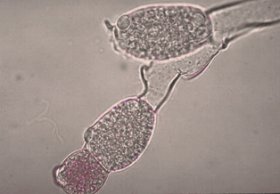
Scientific Classification Fungi
 Naming and Classification of Fungi
Naming and Classification of Fungi
Introduction
Although it is something that we give little thought to, the naming and classification of objects play an important role in society. Imagine the problems that we would have if we were not given names and if we did not name our cities, streets or pets. Now imagine if we did not classify the books that are in our libraries, tools in hardware stores, video tapes in video stores, etc. Without names for objects and a system to classify them, it would be impossible or at least be very difficult to organize, categorize and find information for which we are searching. It should not be a surprise then that there is a discipline in biology called taxonomy that studies the classification and naming of organisms. Presently, there are approximately 1.5 million species of organisms that have been described by biologists and each year thousand of new species are described by science. It is estimated that the total number of species may range from 5 to 30 million. With such a rich diversity of life on this planet, naming and classifying this many organisms would be a difficult task, to say the least. However, such a system must be constructed if our knowledge in biology is to advance.
The job of the taxonomist is a difficult one. The general public thinks of them as snobbish because they refer to organisms with "fancy names". The reputation of the taxonomist is often not regarded in high esteem even among scientist because of its descriptive rather than experimental nature. Christensen (1961), a well respected mycologist-plant pathologist, describes taxonomist as "those who spend their time putting living things into pigeonholes, a low but necessary form of scientific endeavor". The lay person often wonders why taxonomist must refer to onions as Alium cepa or leopards as Panthera pardus. However, they are not using these names just to impress you or to make themselves feel more important in the eyes of their colleagues. Instead, they are merely identifying organisms by their scientific or species name. The species name is called a binomial, which consists of two parts. The first part is the genus (plural: genera) and the second is the specific epithet. For example, the species name for the human animal is Homo sapien. When written, the species name is emphasized by italicizing or underlining the binomial. Each known species, once it has been described by science, is given a unique species name. Another words, there is only one valid scientific name that is unique to a species regardless of where it may may be found. This differs from how society would name an organism. For example when we name our pets or children, the selected names are not unique. After all, how likely is it that anybody at this time would come up with an original, unique name.
Christensen (1961), a well respected mycologist-plant pathologist, describes taxonomist as "those who spend their time putting living things into pigeonholes, a low but necessary form of scientific endeavor". The lay person often wonders why taxonomist must refer to onions as Alium cepa or leopards as Panthera pardus. However, they are not using these names just to impress you or to make themselves feel more important in the eyes of their colleagues. Instead, they are merely identifying organisms by their scientific or species name. The species name is called a binomial, which consists of two parts. The first part is the genus (plural: genera) and the second is the specific epithet. For example, the species name for the human animal is Homo sapien. When written, the species name is emphasized by italicizing or underlining the binomial. Each known species, once it has been described by science, is given a unique species name. Another words, there is only one valid scientific name that is unique to a species regardless of where it may may be found. This differs from how society would name an organism. For example when we name our pets or children, the selected names are not unique. After all, how likely is it that anybody at this time would come up with an original, unique name. In taxonomy those types of names would be referred to as common names, which have been given to many species of organisms. It is not unusual for several common names to be applied to a single species and often a common name may be applied to several species. Although many well known species of organisms have common names, they are not officially used in science because of the confusion that they may cause. For example, the common name "Spanish Moss" is applied to at least two species of unrelated organisms in North America, Ramalina menziesii (Fig. 1) and Tillandsia usenoides (Fig. 2). The former is a lichen, which represents a symbiotic relationship between a fungus and an alga and the latter is a flowering plant.
In taxonomy those types of names would be referred to as common names, which have been given to many species of organisms. It is not unusual for several common names to be applied to a single species and often a common name may be applied to several species. Although many well known species of organisms have common names, they are not officially used in science because of the confusion that they may cause. For example, the common name "Spanish Moss" is applied to at least two species of unrelated organisms in North America, Ramalina menziesii (Fig. 1) and Tillandsia usenoides (Fig. 2). The former is a lichen, which represents a symbiotic relationship between a fungus and an alga and the latter is a flowering plant.
 |
|
|
Figure 1: Ramalina menziesii (Courtesy of Beatrice Senn-Irlet) |
Figure 2: Tilandsia usneoides (Courtesy of David Webb) |
Not only is this an example of a common name that applies to two different, unrelated species, but also one, which is misleading since neither species is a moss, nor is it Spanish. Conversely, Plantago major, a widespread weed, in Europe, is sometimes called "broad leafed plantain", but it also has at least 45 other English common names. Because the European countries speak a number of different languages, there are also 11 French names, 75 Dutch names, 106 German names and many more in other languages (Stern, 1997). Many of these common names may also apply to other unrelated plants. Nevertheless, because common names were the first names that many organisms received and are the names that the general population uses, it is unlikely that the less confusing species names will ever replace common names in our daily usage.
The Development of the Bionomial System and Classification Schemes
A History of Taxonomy
Although the usage of binomials seems to be a simple enough concept, its development took well over a thousand years. In summarizing the events that led to the binomial system, we will concern ourselves mainly with events having to do with plants because fungi as well as algae and bacteria were classified as plants until Whitaker (1969).







